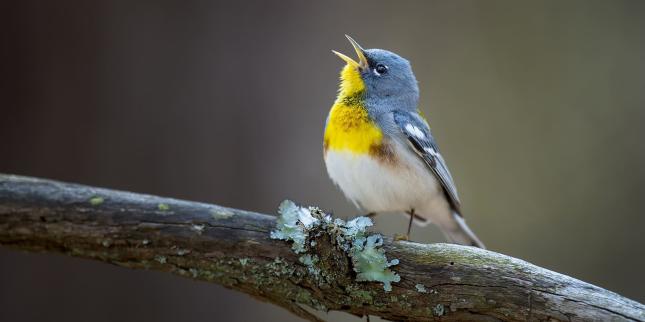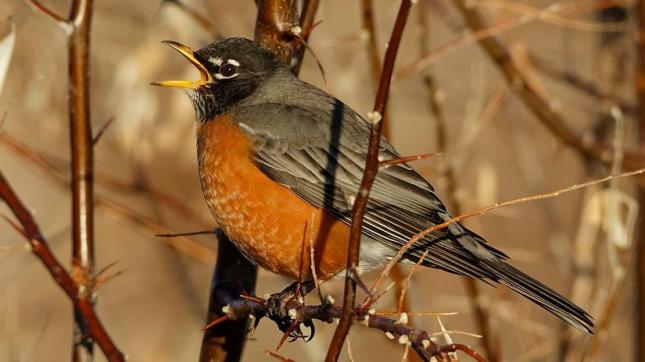Your Backyard in Spring
As days begin to lengthen and sunlight persists into early evening, daffodils and tulips bring splashes of color to o ur flower beds, and tree branches brighten with new buds, these long-anticipated hues of springtime are accompanied by the welcome songs of nature. Some of us are lucky enough to live near an ephemeral pond and look forward to the nightly chorus of Spring Peepers or American Toads. Most of us will recognize the repetitive calls of crickets and katydids on the warmer, more humid nights to come. Nearly all of us are thankful that our next raucous encounter with Brood X Cicadas is a long way off, in 2038. (Look out, Illinois, as you’re in for a double-whammy this summer!)
ur flower beds, and tree branches brighten with new buds, these long-anticipated hues of springtime are accompanied by the welcome songs of nature. Some of us are lucky enough to live near an ephemeral pond and look forward to the nightly chorus of Spring Peepers or American Toads. Most of us will recognize the repetitive calls of crickets and katydids on the warmer, more humid nights to come. Nearly all of us are thankful that our next raucous encounter with Brood X Cicadas is a long way off, in 2038. (Look out, Illinois, as you’re in for a double-whammy this summer!)
Regardless of one’s proximity to water or forest, size of yard, extent of lawn, presence or absence of feeders, etc., ALL of us will soon be surrounded by the annual abundance of birdsong which crescendos each May and reaches a peak in the month of June. An essential element of territorial breeding behavior in almost all smaller avian species, singing is how male birds attract a mate, establish the edges of their territory, and defend that turf from others of their kind. It’s the auditory manifestation of their being ‘twitterpated,’ in Bambi terms! Breeding songs are species-specific, and a single male may repeat his song (and simple variations of it) hundreds, or even thousands, of times each day. While the chorale is loudest within the first few hours of sunrise, some species (vireos, for instance) sing throughout the day, thrushes are particularly vocal just before dusk, and mockingbirds will even sing throughout the night!
There are few sounds as relaxing as the ensemble of voices in the late spring bird chorus. In fact, a growing body of research suggests that taking the time to listen to and appreciate birdsong has tremendous benefits on our mental health, stress levels, and even blood pressure. Do we have to venture deep into the woods or drive to a local park or birding ‘hotspot’ to benefit? Not at all! We already have a local ‘bird station’ in our own neighborhoods and just need to disregard a bit of the static of our busy lives and make more of an effort to tune in. The free app MERLIN can truly help. Its sound detection and species identification capabilities are eye-opening and make even the trained ears of amateur ornithologists aware of distant songs they may not have otherwise detected.
 Eager to surround yourself with the sounds of feathered nesting neighbors? Of course, there are plenty of landscaping projects which can create more appealing breeding habitat in one’s own yard, but these can take years to reap results. In the short term, however, simply adding several nest boxes can make one’s property much more attractive to songbirds looking for a suitable place to raise their families. Homeowners with large lawns or near farmland or ponds may be able to entice Eastern Bluebirds, Tree Swallows, or even Purple Martins to move in. More wooded properties can lure Carolina Chickadees, Tufted Titmice, or Carolina Wrens (all secondary cavity-nesters) to nest in boxes. Most suburban backyards can fairly easily attract House Wrens to small bird houses and House Finches to hanging planters. All of these new neighbors will thank you by providing hours of musical entertainment, even if you are not their intended target audience.
Eager to surround yourself with the sounds of feathered nesting neighbors? Of course, there are plenty of landscaping projects which can create more appealing breeding habitat in one’s own yard, but these can take years to reap results. In the short term, however, simply adding several nest boxes can make one’s property much more attractive to songbirds looking for a suitable place to raise their families. Homeowners with large lawns or near farmland or ponds may be able to entice Eastern Bluebirds, Tree Swallows, or even Purple Martins to move in. More wooded properties can lure Carolina Chickadees, Tufted Titmice, or Carolina Wrens (all secondary cavity-nesters) to nest in boxes. Most suburban backyards can fairly easily attract House Wrens to small bird houses and House Finches to hanging planters. All of these new neighbors will thank you by providing hours of musical entertainment, even if you are not their intended target audience.
On the whole, North American bird populations have declined 30% since 1970. Reversing this trend will require major policy changes, land use practices, and rethinking of priorities on a national scale. On a more personal level, however, each of us can take small actions to help save our songbirds. Inviting feathered friends to nest on your property by putting up a few boxes is an easy first step—and you can get them for a song!

